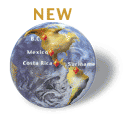|
||||||||||||||||||
|
|
|
|
||||
|
NEWS RELEASENew Metallurgical Tests Significantly Increase Gold Recoveries From High Grade New Polaris Ore
Vancouver, British Columbia, Canada, January21, 2003Canarc Resource Corp. (CCM:TSX and CRCUF:OTC-BB) announces that new metallurgical test work on a mini-bulk sample of high grade gold ore from the New Polaris mine site in northwestern British Columbia has significantly increased the gold recoveries.
New Polaris is Canarc’s principal gold development project. This high grade underground mine produced almost 250,000 oz gold from 1938 to 1951 when it was thought to be mined out. However, since 1990, Canarc has invested over US $12 million to delineate a 1.3 million oz gold resource that is still open for expansion.
Previous metallurgical studies recovered up to 90% of the gold in New Polaris ores but new flotation and leaching tests indicate up to 98.7% of the gold can now be recovered through standard procedures. Resource Development Inc. (RDI), a widely respected metallurgical consulting company in the mining industry, has reported the following initial test results:
1. Approximately 150 kg of ore sample was crushed and ground to 80% passing – 200 mesh and assayed 19.5 gpt Au, 2.84% As, 1.90% S and 0.013% Sb.
2. A diagnostic leach test indicated that 9% of the gold is free milling, 69% is refractory associated with arsenopyrite and pyrite and the remaining 22% occurs with the quartz-carbonate matrix.
3. A standard flotation test recovered 83.6% of the gold into a rougher concentrate weighing 20.7% of the original sample. Another sample was sulphidized prior to flotation and recoveries jumped to 93.8% of the gold and 93.9% of the arsenic in a rougher concentrate grading 94.2 gpt Au.
4. A cyanide leach test on the rougher tailings recovered approximately 80% of the remaining gold for a total recovery of up to 98.7% of the gold.
5. Single stage cleaner flotation work reduced the concentrate weight to 11.4% of the original sample and improved the concentrate grade to 125.9 gpt Au but gold recoveries dropped to 88.6%.
On the basis of these new test results, Canarc can consider two alternative scenarios for the gold recovery mill circuit at New Polaris. The first scenario calls for the production of a concentrate for treatment in a bio-leach plant to recover the gold from the con and produce doré gold bars onsite.
The second scenario entails the production of a concentrate for shipping to an autoclave treatment facility to recover the gold from the con and produce doré gold bars offsite. In both scenarios, additional gold recoveries would be achieved by putting a small cyanide leach circuit in the mill onsite to capture 80% of the gold in the tailings.
RDI will now process the remainder of the mini bulk sample to produce a bulk rougher concentrate. A 10 kg concentrate sample will be shipped to a laboratory in South Africa that specializes in bio-leach test work. Additional cleaner tests will also be run by RDI to characterize and optimize the flotation studies.
Bacterial leaching, or bio-leaching, of refractory gold ores has become a common pre-treatment process in the mining industry in recent years. There are several commercial bio-leach plants currently operating in Australia and Africa.
If bio-leach tests on the New Polaris concentrates are successful in recovering most of the contained gold, then the bio-leach scenario becomes an attractive economic alternative to the autoclave scenario because it would not require road access and the capital and operating costs are significantly lower for a bio-leach plant.
Alternatively, if Redcorp proceeds with the construction of their recently-permitted Tulsequah Chief copper-zinc mine and road adjacent to New Polaris, then the autoclave scenario becomes equally attractive because shipping to an existing autoclave would significantly reduce the anticipated capital and operating costs of the New Polaris gold mine.
Once the initial bio-leach tests are completed, Canarc plans to redo the scoping study on New Polaris to re-assess the project economics. A marked reduction of both capital and operating costs is conceivable given the two attractive scenarios that have now been developed.
Canarc Resource Corp. is a growth-oriented, gold exploration and mining company listed on the TSX (symbol CCM) and the OTC-BB (symbol CRCUF). The Company’s principle asset is its 100% interest in the 1.3 million oz New Polaris gold deposit located in northwestern British Columbia. Major shareholders include Barrick Gold Corp. and Echo Bay Mines Ltd. ON BEHALF OF THE BOARD OF DIRECTORS CANARC RESOURCE CORP. Bradford J. Cooke President and CEO
|

|
|||
disclaimer |
||||

